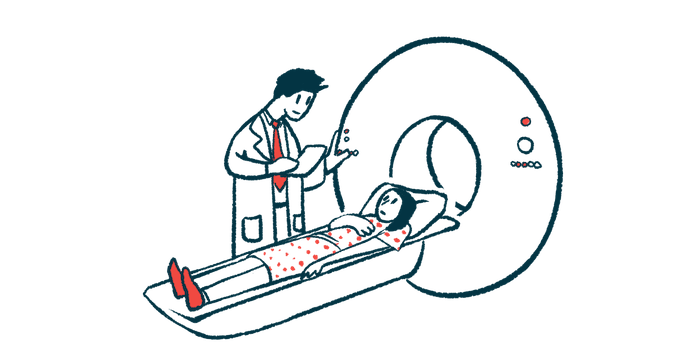New MRI technique may help detect nerve damage in FAP: Study
Noninvasive method could also identify potential biomarkers of disease severity

A specialized MRI technique known as the variable echo time (vTE) sequence may help identify structural changes in nerves linked to damage in individuals with familial amyloid polyneuropathy (FAP), according to a recent study.
Additionally, a parameter of the vTE MRI sequence called short T2-weighted imaging was identified as being associated with disease severity and abnormal results in nerve conduction studies, which measure how well nerves can transmit electrical signals.
This suggests “the vTE sequence provides novel and reliable imaging markers capable of detecting early nerve microstructural changes related to disease onset and severity,” according to researchers.
The study, “Quantitative MRI Assessment Using Variable Echo Time Imaging of Peripheral Nerve Injury in ATTRv Amyloidosis Patients,” was published in the European Journal of Neurology.
MRI technique takes snapshots of body tissue
FAP is a form of hereditary transthyretin amyloidosis, or ATTRv, a group of disorders caused by mutations in the TTR gene. These mutations result in misfolded transthyretin proteins that aggregate into toxic amyloid fibrils. In FAP, these fibrils primarily accumulate in peripheral nerves — those outside the brain and spinal cord — causing progressive nerve damage and related symptoms.
The disease diagnosis usually involves genetic testing, tissue analysis to detect the presence of amyloid fibrils, and nerve conduction tests.
In this study, researchers at Italy’s University of Pavia analyzed whether vTE, a new specialized technique to acquire MRI images, could be used as a noninvasive method to detect nerve injury in people with FAP and to identify potential biomarkers of disease severity.
This technique is a special type of MRI scan that takes multiple snapshots of body tissues at different time points during a scan, and can be thought of as using different filters on a camera to reveal details that would otherwise be hidden.
Eighteen people with confirmed FAP, as well as 22 age- and sex-matched healthy controls, were included in the analysis. Participants with FAP were mainly men (11 patients) with a median age of 61.6 years and a median disease duration of 4.5 years. The most common TTR mutations were Val30Met and Phe64Leu, each of which were present in 22% of the patients.
More than half had a Polyneuropathy Disability (PND) score of 1, which corresponds to sensory disturbances with preserved walking ability, and most (83.3%) were receiving treatment, particularly with tafamidis meglumine (72.2%).
Most study participants had mild or moderate disease
Participants underwent detailed neurological assessment and were classified as having mild (11 patients), moderate (five patients), or severe (one patient) disease based on the Neurologic Impairment Score for the lower limbs (NIS-LL). The median NIS-LL score among FAP patients was 11, which corresponds to mild disease. One of the 18 patients did not perform clinical assessment at the time of the MRI and was excluded from the statistical analysis.
In the vTE MRI assessment, participants with FAP showed significantly higher values for both sciatic nerve signal and fascicle short T2-weighted imaging, known as pT2-star, compared to healthy controls. The pT2-star parameter is sensitive to structural changes in nerve tissue and serves as a marker for detecting nerve damage. Higher pT2-star levels indicate greater nerve injury.
The sciatic nerve starts in the lower back and runs down the back of the legs. Nerve fascicles are small bundles inside the nerve that carry signals.
According to the researchers, these results show “the sensitivity of the vTE sequence in assessing nerve injury,” which “enables the detection and quantification of [large molecules’] content variations within the nerve.”
The cross-sectional area of the sciatic nerve and fascicles was also higher in patients than in healthy controls, which may reflect nerve swelling or structural changes caused by amyloid deposits and nerve damage.
PT2[star] appears to reflect the severity and extent of motor [nerve fiber] loss and/or degeneration. This is clinically relevant because pT2[star] is measurable and, therefore, applicable for disease monitoring in even more advanced stages.
Higher pT2-star values were found in these larger fascicles, indicating more severe nerve injury. No differences were found regarding the epineurium, the outer layer of the nerve, suggesting the damage and changes are mainly occurring within the nerve fibers themselves rather than in the surrounding tissue.
Further analysis indicates T2-star levels correlated with patients’ PND and the NIS-LL scores, with participants with increased values showing more severe disease. In addition, higher pT2-star levels in fascicles were associated with worse nerve conduction parameters of motor and sensory nerves in the lower leg.
This suggests that “pT2[star] appears to reflect the severity and extent of motor [nerve fiber] loss and/or degeneration,” the researchers wrote. “This is clinically relevant because pT2[star] is measurable and, therefore, applicable for disease monitoring in even more advanced stages.”







